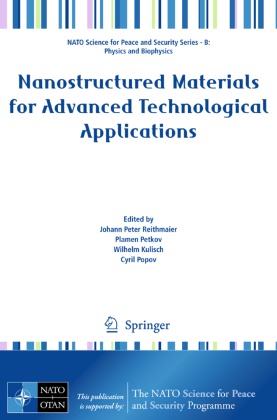Mehr lesen
Nanoscience and Nanotechnology are experiencing a rapid development in many aspects, like real-space atomic-scale imaging, atomic and molecular manipulation, nano-fabrication, etc. , which will have a profound impact not only in every field of research, but also on everyday life in the twenty-first century. The common efforts of researchers from different countries and fields of science can bring complementary expertise to solve the rising problems in order to take advantage of the nanoscale approaches in Materials Science. Nanostructured materials, i. e. materials made with atomic accuracy, show unique properties as a consequence of nanoscale size confinement, predominance of interfacial phenomena and quantum effects. Therefore, by reducing the dimensions of a structure to nanosize, many inconceivable properties will appear and may lead to different novel applications from na- electronics and nanophotonics to nanobiological systems and nanomedicine. All this requires the contribution of multidisciplinary teams of physicists, chemists, materials scientists, engineers and biologists to work together on the synthesis and processing of nanomaterials and nanostructures, und- standing the properties related to the nanoscale, the design of nano-devices as well as of new tools for the characterization of nano-structured materials. The first objective of the NATO ASI on Nanostructured Materials for Advanced Technological Applications was to assess the up-to-date achie- ments and future perspectives of application of novel nanostructured materials, focusing on the relationships material structure ? functional properties ? possible applications.
Inhaltsverzeichnis
Nanostructured Materials for Advanced Technological Application: a brief Introduction.- Low temperature variable-range hopping in disordered solids: The failure of the Mott "T-1/4" model and the demonstration of a new procedure.- On the validities and limitations of transient photo-decay techniques for identifying the energy distribution and related properties of localized states in disordered semiconductors.- Composite films with nanosized multilayer particles: Numerical modeling of their optical response.- Two-photon lasing in micro-cavities.- Interference of cooperative resonant fluorescence from two distant systems of radiators.- Modelling the cohesive energy of chalcogenide nanoparticles.- Quantum-dimensional effects in the positron annihilation spectra of La-Ba-Cu-O superconductors.- Examples of current industrial micro- and nanomaterials and techniques for their characterization.- Raman spectroscopy of UNCD grain boundaries.- Structural study of multi-component glasses by the Reverse Monte Carlo simulation technique.- Dynamic light scattering as a probe of nanosized entities: Applications in materials and life sciences.- The collapse of hydrodynamic radii in pluronic PE6400 micelles in vicinity of supramolecular transition: Dynamic light scattering, heat capacity and sound velocity measurements.- Some structural modifications at the nanometric scale induced by swift heavy ion irradiation.- Fabrication of metal nanoparticles in polymers by ion implantation.- Rapid Laser prototyping of polymer-based nanoplasmonic components.- Design of ceramic microstructure of nanoscaled transitional alumina.- Carbon nanotube composite materials: Opportunities and processing issues.- Laser ablation of CdSe and ZnO: alkylamine assisted formation of magic clusters.- Synthesis and characterization of silver/silica nanostructures.- ZnO nanostructures grown by thermal evaporation and thermal decomposition methods.- Antimicrobial effects of silver nanoparticles synthesized by an electro-chemical method.- The effect of Au nanoclusters in tin oxide film gas sensors.- Preparation and some characteristics of polyepoxypropylcarbazole thin films with embedded Au-Ag nanoparticles.- Nanostructural carbonaceous films with metal (Pd, Ni) nanoparticles.- Nanostructured ionic conductors: investigation of SiO2-MI (M=Li, Ag) composites.- Preparation and properties of flexible nanocomposites, obtained by a combination of colloidal chemistry and sol-gel approach.- Template synthesis of mesoporous silicas inside nanoreactros based on large pores of silica gel.- Nanocrystalline metastable hard coatings.- Influence of the precursor materials on the structural properties of poly-Si thin films obtained by aluminium-induced crystallization.- Sensitivity of ZnO films doped with Er, Ta and Co to NH3 at room temperature.- Pulsed laser deposition of layers and nanostructures based on CdTe and Bi.- Ternary Ge-Se-(B, Ga, T1) chalcogenides - preparation, properties and applications.- Study of (As2Se3)100-x (AgI)x thin films prepared by PLD and VTE methods.- Physico-chemical characterization of nanostructured As-Se-Ag glassy materials.- Atomic structure of As34Se51Ag15 and As34Te51Ag15 glasses studied with XRD, ND and XAFS and modeled with RMS.- Thermal behavior of novel (GeS2)1-x(AgI)x glasses.- Microstructural, morphological and optical characterization of As2Se3-As2Te3-Sb2Te3 amorphous layers.- Nanocolloidal solutions of As-S glasses and their relation to the surface morphology of spin-coated amorphous films.-
Über den Autor / die Autorin
Wilhelm Kulisch lehrt seit über zehn Jahren Physik an der Universität Kassel. Neben der Technischen Mechanik unterrichtete er lange Zeit auch Nebenfachstudenten in Experimentalphysik.
Zusammenfassung
Nanoscience and Nanotechnology are experiencing a rapid development in many aspects, like real-space atomic-scale imaging, atomic and molecular manipulation, nano-fabrication, etc. , which will have a profound impact not only in every field of research, but also on everyday life in the twenty-first century. The common efforts of researchers from different countries and fields of science can bring complementary expertise to solve the rising problems in order to take advantage of the nanoscale approaches in Materials Science. Nanostructured materials, i. e. materials made with atomic accuracy, show unique properties as a consequence of nanoscale size confinement, predominance of interfacial phenomena and quantum effects. Therefore, by reducing the dimensions of a structure to nanosize, many inconceivable properties will appear and may lead to different novel applications from na- electronics and nanophotonics to nanobiological systems and nanomedicine. All this requires the contribution of multidisciplinary teams of physicists, chemists, materials scientists, engineers and biologists to work together on the synthesis and processing of nanomaterials and nanostructures, und- standing the properties related to the nanoscale, the design of nano-devices as well as of new tools for the characterization of nano-structured materials. The first objective of the NATO ASI on Nanostructured Materials for Advanced Technological Applications was to assess the up-to-date achie- ments and future perspectives of application of novel nanostructured materials, focusing on the relationships material structure ? functional properties ? possible applications.

